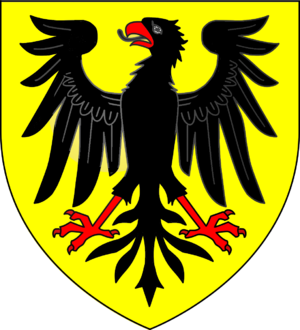Sir Peter Temple, 2nd Baronet facts for kids
Sir Peter Temple (born October 15, 1592 – died September 12, 1653) was an important English politician. He served in the English Parliament for many years, from 1640 to 1653. During the English Civil War, he supported the Parliament, who were also known as the Roundheads.
Contents
Sir Peter Temple's Family Life
His Parents and Inheritance
Peter Temple was the son of Sir Thomas Temple, who was the first Baronet of Stowe. His mother was Hester Sandys. When his father passed away in 1637, Peter inherited the title of Baronet.
His Marriages and Children
Sir Peter married twice. His first wife was Ann Throckmorton. They had two daughters. The older daughter, Anne, lived to be old. Their younger daughter, Martha, sadly passed away when she was very young.
Later, he married Christian Leveson. They had several children together. Their oldest daughter, Frances, married the Earl of Londonderry. Sir Peter's oldest son, Richard Temple, became the next Baronet after his father.
A Family Disagreement
Sir Peter had a long-standing disagreement with his daughter Anne. She married Thomas Roper without her father's permission. Anne and her husband later went to court. They wanted to get her inheritance from her mother, Anne Throckmorton Temple.
Sir Peter Temple's Public Role
Serving Buckinghamshire
In 1634, Sir Peter worked as the High Sheriff of Buckinghamshire. This meant he was in charge of the county's law and order. He also had to collect a special tax called "ship money." This tax was very unpopular at the time.
Member of Parliament
In April 1640, Sir Peter was chosen to be a Member of Parliament for Buckingham. This was for a short meeting of Parliament. He was chosen again in November 1640 for the Long Parliament.
He chose to support the Parliamentarians during the English Civil War. He even fought for them. Interestingly, his wife, Christian, supported the Royalists, who were on the other side. Sir Peter was asked to be a judge in the trial of King Charles I. However, he never actually attended any of the court sessions.
Relationship with His Father
Sir Peter had a difficult relationship with his father, Sir Thomas. His father accused him of spending money unwisely. Sir Peter also felt that his father preferred his younger brother, John.
In the 1620s, his father wanted to sell some land to pay off his debts. Sir Peter, who also had many debts, went to court to try and stop the sale. Eventually, their family dispute was settled in the 1630s. His father was allowed to sell the land. However, he had to make a payment to Sir Peter.
In 1625, Sir Peter's parents moved out of their large house at Stowe. They let Sir Peter live there and take care of the estate. Sir Peter made many changes to the building. From 1637 to 1643, he lived in London at Tavistock Row in Covent Garden.


